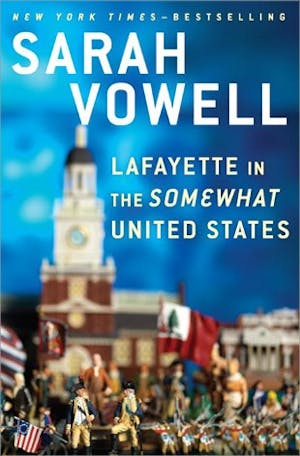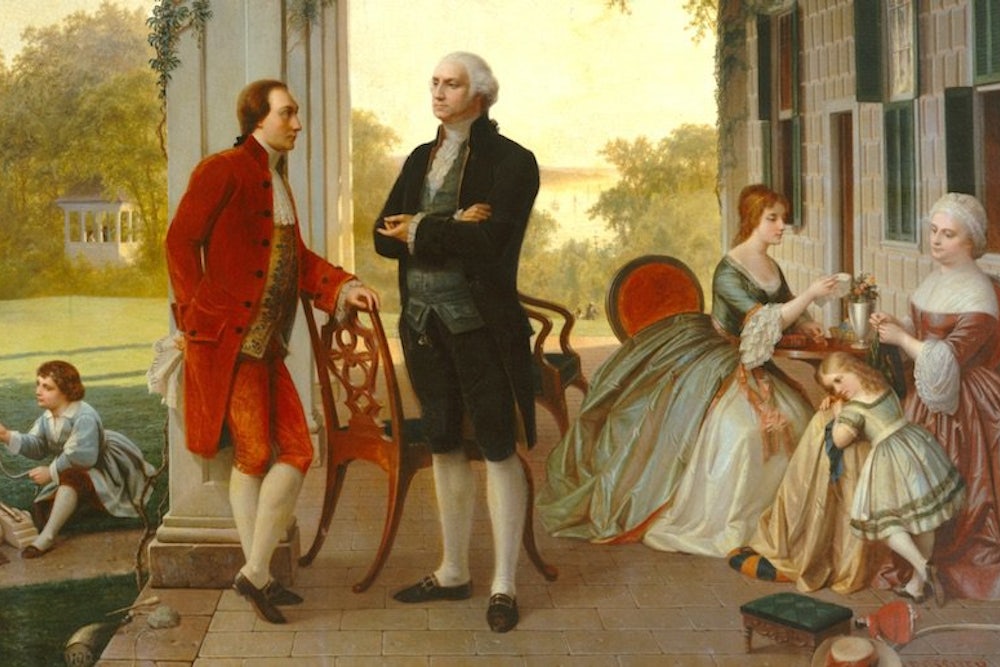One hundred and ninety years ago, in 1824, forty-three years after the British surrendered at Yorktown, and 140 years before the British Invasion, Marie-Joseph-Paul-Yves-Roch-Gilbert du Motier, best known as the Marquis de Lafayette, received a rock star’s welcome upon his return to America, his first since he’d helped secure the country’s independence. An invitation to be the “nation’s guest” from President James Monroe on the occasion of the republic’s 50th anniversary turned into a yearlong, 6,000-mile grand tour of the then twenty-four states. When he landed in New York harbor, 80,000 people, nearly 65 percent of New York City’s population at the time, greeted his ship.

Sarah Vowell chronicles the victory lap in her new book Lafayette in the Somewhat United States, when the marquis was was seventy-seven years old and the Continental Army’s last living General. But when he had set sail for the New World in 1777, Lafayette was nineteen-years old—rich, orphaned, a new husband by an arranged marriage, as well as a brand new father, rejecting both his family and his king’s wishes that he stay in France. His reason? Vowell sums it up this way: “A juvenile lust for glory, the appeal of escaping his nagging in-laws, boredom with the court shenanigans of Versailles, and a head full of Enlightenment chitchat about liberty and equality.” But above all, his quest to help the Americans was a yearning for revenge—it was a British cannonball that killed his father in the Seven Years War.
What did America do with the teenager when he arrived? They made him a major general in the Continental Army without pay, “an unpaid intern in a general’s sash,” writes Vowell. The orphaned Lafayette soon found himself welcomed by the nation’s new father figure, George Washington, who told Lafayette to “consider himself at all times one of the family.”
Vowell’s past journeys into American history—the assassinated presidents in Assassination Vacation, the Pilgrims in The Wordy Shipmates, the forming of Hawaii as a state in Unfamiliar Fishes, and a collection of essays about her uneasy patriotism with The Partly Cloudy Patriot—are a testament to her absolute obsession, not with American nationalism, but American history; the plaques, roadside markers, reenactments, and historical buildings that make up this country’s robust and kitschy historical tourism market. It is through her visits to these landmarks that Vowell finds her love for her a country where commerce trumps historic preservation in most circumstances.
“This place looks wrong,” observes Vowell while she looks for Lafayette in Pennsylvania’s Brandywine Valley. “I’m not bothered that the present intrudes on the past, what with the combination Pizza Hut-Taco Bell looming near a road once crammed with redcoats; or that Fuzzy Butts Dog Day Care is situated a stone’s throw from the old Quaker house where Lafayette reportedly spent the night before the battle.” Instead it irritates her that she’s visiting in springtime, when her knowledge of the area is based on the lifeless frozen landscape of Andrew Wyeth’s paintings.
Is Vowell’s writing the tautest, most thorough, or the most salient on her historical subjects? No, but it’s not meant to be either. Vowell is a wonderful summer-upper, and that is a great skill to have when sorting through the minutiae of detail generated by the administration of founding a nation. Vowell has chosen wisely to stick herself to Lafayette in a book that looks at the American Revolution, because through his puppy love with America she can tease out some of the significant divisions our founding fathers struggled to resolve. And yet, Lafayette is a departure for her. The dude is French after all, which means Vowell must leave home soil for France to begrudgingly visit her “least favorite building on earth, the morally and architecturally bankrupt compendium of gilded nonsense and silken flimflam known as the Château de Versailles.”
Despite his flimflam origins, Vowell has found in Lafayette a clear lens with which to view the nation’s founding. Lafayette’s complete and utter patriotism and devotion to the United States of America are more unfaltering than her own and most other Americans, of today and yesteryear. His Grand Tour coincided with one of the most contentious elections in American history, in which John Quincy Adams prevailed despite not receiving the most electoral votes. Lafayette, somehow, was the one of the few people who could unite the country in bipartisanship. “We the people have never agreed on much of anything,” sums-up Vowell. But, she notices, everyone digs Lafayette, and so she digs into him.
Vowell’s Lafayette, is not so much a biography of the Frenchman as an easily digestible and tasty American Revolution sandwich. It’s Lafayette at the beginning, Lafayette at the end, and a little Lafayette peppered throughout the layers of battle and skirmish, and nearly naked soldiers starving by the hundreds at Valley Forge. We the people all need a little reminder of our founding from time to time, particularly because of our ridiculous penchant to think we pulled ourselves up by our own bootstraps. Vowell is here to remind us that Lafayette, via constantly applied pressure on the French, paid for the boots. Despite his crucial role, we don’t quite remember who he is or what he did. “Nowadays, Lafayette is a place, not a person” writes Vowell, referring to all the cities and roads and squares being renamed for him in 1825 on his Grand Tour.
Despite my general fondness for Vowell’s loose style, there are a few places her throwaway remarks made me wince. The worst is an unfortunate passage where she wonders if the starving soldiers of Valley Forge, two thousand of whom died from hunger and exposure, would have envied the slaves at Thomas Jefferson’s Monticello, where they would have received a weekly food ration of “two gallons of cornmeal, a half pound of pork or beef, four to five salted fish, a bit of molasses,” which also was not enough food to subsist on either, and required the slaves to supplement with their own gardens. How disappointing to read this strangely regressive thought—that soldiers would have traded their pursuit of freedom for slavery, their personhood for a lack of one.
In its place, imagine this: many of Thomas Jefferson’s slaves, which he called “laborers,” who he wished to be, in his words, “well-treated,” despite offering no guarantees, would likely given up their sweet molasses for a shot at liberty given the option, even if it meant death in a camp led by George Washington. What is that thing Patrick Henry said?
Vowell’s writing is made up of sugar and spice and everything snark, and sometimes a poorly executed pondering. But that fits right in with the ongoing tone of the nation since its very founding. Lafayette wouldn’t expect anything less, after naively coming to America believing that all its founders were united to discover that Americans have a “fatal tendency of disunion.” Yes, yes we do. And it is a relief to be reminded that it is an ongoing state, rather than a current crisis.
At least we can agree on one thing. Somewhat forgotten Lafayette is the United States of America’s best friend, and Lafayette is our country’s biggest fan. The General is currently is one of the supporting stars of the Broadway musical Hamilton, a show in which biography is destiny, where chorus earnestly asks at the end, “Who lives? Who dies? Who tells your story?” Lafayette is lucky he has Sarah Vowell in his court.
